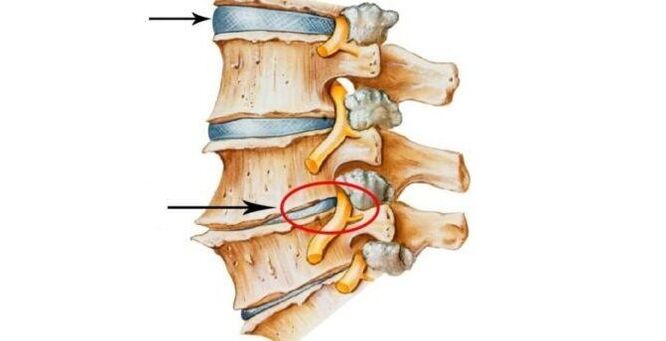With cervical osteochondrosis, cervical discs and vertebral bodies age rapidly. Dizziness and headache are the main symptoms. In most cases, the most mobile part of the spine changes.

reason
The fact that osteochondrosis only develops in old age is an illusion. In recent years, signs of cervical osteochondrosis have been found in young adults aged 16-20. The disease appears due to the following reasons:
- Violation of metabolic processes.
- Abuse of tobacco and alcohol.
- Low physical activity (fatigue).
- Hurt.
- Sitting for long periods of time.
- excess weight.
- sleep disorder.
- Genetic susceptibility.
Symptoms of cervical osteochondrosis are often confused with a cold or general fatigue. If signs of illness appear, seek medical attention as soon as possible.
symptom
There is a spectrum of symptoms in which the spinal cord root is invaded and the veins and arteries passing through the vertebral body narrow. Cervical spondylosis (radiculopathy) manifests as numbness in the shoulder blade, shoulder, and arm area, as well as pain and tingling. Neck and chest (front) discomfort may be experienced.
The first signs of cervical osteochondrosis are:
- mild neck pain;
- The creaking sound when the head is turned, when it is turned;
- Periodic pain in the head and neck, heaviness in the back of the head, numbness in the arms and shoulders.
Dizziness is a symptom of cervical osteochondrosis that appears after waking up at night or in the morning. Dizziness occurs when the patient rotates the head several times.
As dizziness manifests, it occurs:
- lose direction in space;
- There is a feeling of "staggered floor" under the feet;
- lost balance;
- noise and tinnitus;
- nausea and vomiting;
- redness or paleness of the face;
- Headache and increased sweating.
Dizziness attacks cause blurred vision, increased heart rate, numbness in hands, and "flies" in front of your eyes.
Preventive measures for dizziness are proper nutrition (adequate B and C vitamin content) and proper sleeping arrangements (low pillows, firm mattresses). Medications for dizziness aim to normalize blood circulation to the brain.
getting sicker
Symptoms of worsening cervical osteochondrosis may include the following:
- Occipital and neck pain, transmitted to the arms, shoulder blades, and shoulders.
- Pain worsens with head movement, sneezing, or coughing.
- Forced position of the head (for pain relief).
- Pain can be localized in different places, which can interfere with diagnosis.
- Long-term headache and dizziness.
- Violation of visual, auditory, motor coordination.
- Against the background of general weakness, increased muscle tone in the extremities and neck.
- Reduce skin sensitivity (numbness, dryness, tingling, cold).
- Sleep disturbance, memory disturbance, increased anxiety.
To check the condition of the blood vessels in the neck, diagnostic methods are used - duplex scanning or ultrasound Doppler contrast.
complication
Symptoms that are not detected and treated in time can lead to the following complications:
- A protrusion (bulge) between the cervical vertebrae.
- Hernias (intervertebral discs) in the area of the cervical spine.
- Radiculopathy (damage to one or more nerve roots).
- The formation of cervical large osteophytes.
- Paralysis (incomplete paralysis).
- Squeeze the arteries that supply the brain.
- Dupuytren's contracture. Pathologically, the palm is deformed, the fingers are compressed, and the hand no longer functions properly.
Osteochondrosis and VVD
The VVD (vegetative vascular dystonia) symptoms of cervical osteochondrosis are interrelated. These pathologies are links in the same chain that require more attention, diagnosis, and treatment. Often, vegetative vascular dystonia is the result of cervical osteochondrosis.
Dystonia is accompanied by the following symptoms:
- dizziness.
- Palpitations and pain in the heart area.
- Respiratory disease (increased breathing, lack of air).
- Blood pressure drops.
- Diseases of the internal organs (stomach, intestines, urinary organs).
- Changes in body temperature during the day (from 35 to 38 degrees).
- Irritability, tears, anxiety.
The development of phytovascular dystonia may be due to hormonal exhaustion, endocrine disorders, excess body weight, and genetic predisposition. The main symptoms of cervical spondylosis VVD: muscle fatigue, impaired body control.
The presence of these signs requires a correct diagnosis, which is only possible after a complete examination. Self-treatment of disease is unacceptable!
diagnosis
The examination begins with the examination and analysis of all patient complaints. Diagnosis allows to exclude diseases of the heart and blood vessels, stomach and intestines. Diagnostic measures include:
- radiography.
- CT (Computed Tomography).
- MRI (magnetic resonance imaging).
- Myelography.
To determine the degree of sensory and motor impairment, a neurological examination is performed.
treatment of disease
Treatment measures are aimed at reducing inflammation and pain relief in the affected area. Drug regimens are represented by the following drug groups:
- Non-steroidal anti-inflammatory drugs (NSAIDs).
- Chondroprotectants - Drugs that stop cartilage destruction and help restore cartilage tissue.
Treatment with ointment is common, but not very effective. Self-medicating patients use ointments containing irritating substances, or ointments in the NSAID group. The medicinal substances in the ointment will not be able to penetrate the dense layers of skin and muscle to reach the lesion.
Significant benefits of neck massage ointment while rubbing medicine.
Symptoms of cervical osteochondrosis are treated with B vitamins. Combination preparations for intramuscular injection have been shown to work well. The ingredients of this solution include B vitamins: Cyanocobalamin (B12), Pyridoxine (B6), Thiamine (B1).
Comprehensive treatments include: physiotherapy, acupuncture, leech therapy (leech therapy), massage, exercise therapy (physiotherapy), manual therapy.
This video introduces the neck exercise therapy complex. The daily performance of these exercises will help to get rid of unpleasant symptoms.
prevent disease
To prevent the development of cervical osteochondrosis, it is recommended to warm up regularly at work, avoid neck pressure, do not make sudden head movements, monitor posture, avoid hypothermia, exercise, and eat right.



















